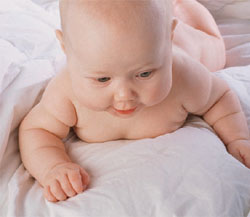A six-month-old baby is a lot of fun. Compared with the earlier months, she is now more aware of her surroundings and is eager to participate in conversations, always hungering for attention. She is now able to smile and laugh, and parents often look forward to spending time with their babies after work.
As her brain continues to mature, her movements become more refined and coordinated. Her vision also improves and she is now able to see better compared with the time she was born.
Her hand-eye coordination is also improved and, as a result, she is able to reach for objects and take them to her mouth.
Her inability to discriminate food from non-food items, however, means that all too often spectacles, hair bands and even jewellery are pulled and end up covered with saliva. Reprimanding her often results in a hearty laugh which you cannot help but join in.
Conversation, which was limited to cooing before, has now become more sophisticated as she has learned to join a consonant to a vowel. She now babbles, initially short phrases but later long sentences with varying tone and pitch. There is much joy to be found in talking to a child of this age as she gazes at you intently then replies in her own sing-song babbling. Unfortunately, this may also occur when she wakes up for her midnight feed!
She is also able to locate sounds at her ear level, and turns to them. Shaking a rattle at a distance of about 1 metre, at ear level will have her turning towards its direction. This is also a sign of a maturing brain. Play mats and baby gyms become more meaningful as she is able to reach for the dangling toys and scrutinise the colourful pictures on the mat.
In terms of motor development, she is now very adept at turning from her tummy to her back and vice versa. With some practice she is able to move from one part of the room to another simply by rolling over. This means that she can no longer be left unattended, especially on raised surfaces such as a bed, as she may roll off the bed and injure herself.
Her muscle tone is good and she is able to hold her head up when carried upright, no longer needing support. This enables her to see her surroundings while she’s being carried, something she enjoys.
When left on her tummy, she is able to raise her body off the bed/mat and support her weight on her hands, a sign that she is preparing to crawl. Some babies may start crawling at this stage, others a little later. She is able to sit with a straight back but needs to be supported.
At six months, she is still friendly with everyone as she has not developed stranger anxiety. This is an excellent time to show her off to your in-laws, parents and peers as soon she will start screaming whenever someone unfamiliar tries to take her or approaches her.
Many parents buy infant walkers for their babies at this age. This is not a good idea as infant walkers are dangerous and can result in serious injury. Furthermore, contrary to popular belief, they do not hasten the walking process but instead slow down motor development. Instead, allow her to lie on a play mat or duvet while you read or watch the television. She will soon crawl, stand and walk at her own pace.
Some babies may start teething at this age. If this troubles her, allow her to bite on a teether, and if this fails to pacify her, discuss with your doctor about teething gel. Very often, no medical intervention is needed. Substituting the teether with a finger often does the trick.
Entertainment for your six-monthold baby should include lots of talking, singing and cuddling. She is attracted to colours and sounds, and brightly coloured cloth books, especially those which make sounds. She is now able to shake her own rattle and finds the colourful pictures on playmats intriguing. Music has been found to be helpful in stimulating children’s brains and singing to her will provide entertainment both for you and her. You may not be a Malaysian Idol, but you will always be her idol.






Comments